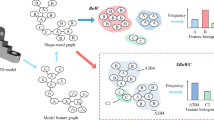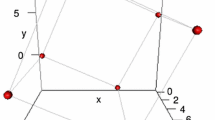Abstract
Matching, clustering, and retrieving 3D CAD models of mechanical components based on their shape are useful for many CAD/CAM applications such as design reuse, variant process planning and group technology. Surfaces are the prominent elements of the B-Rep (Boundary Representation) CAD model, but the current methods of similarity assessment are not centered on the surfaces and lack an accurate description of their geometric features. In order to solve the problem of retrieval and clustering of B-Rep models more efficiently, the concept of “most crucial surface” is proposed and its corresponding characteristics are studied in detail. The contribution of our approach is that surfaces are the major shape determinants of the B-Rep model, and the distribution of Carosati curvatures is the optimum shape features of surfaces. First, the surface elements are extracted from the STEP (Standard for Exchange of Product Model) files of the B-rep models, and the distribution of minimum, Gauss and Carosati surface curvatures are converted into the shape feature space by the wavelet transform, the Fourier transform, and the grouping calculation. Thus we characterize the B-Rep model as a histogram with surfaces as bins, and then compare and cluster the B-Rep models by the bipartite matching algorithm or the earth mover’s distance. The surface-based methods are evaluated with the four effectiveness indices in the clustering experiment of the NDR (National Design Reservoir) data, and the results indicated that the grouping method for the surface Carosati curvatures has a highly competent matching and clustering performance.





Similar content being viewed by others
References
Adem C (2007) STEP based geometric and topological similarity assessment of mechanical parts. Mathematical Comput Appl 12(3):141–150
Andreopoulos A, Tsotsos JK (2013) 50 years of object recognition: directions forward. Comput Vision Image Understanding 117(8):827–891
Barlow HB (1983) Vision: a computational investigation into the human representation and processing of visual information. J Math Psychol 27(1):107–110
El-Mehalawi, M., & Miller, R. A . (2003). A database system of mechanical components based on geometric and topological similarity. Part II: indexing, retrieval, matching, and similarity assessment. Comput Aided Des, 35(1), 95–105.
El-mehalawi M, Miller RA (2003) A database system of mechanical components based on geometric and topological similarity. Part I: representation. Comput Aided Des 35(1):83–94
Fradi, A., Borhen, L., Mohamed, A. M., & et al. (2018). 3D object retrieval based on similarity calculation in 3D computer aided design systems. IEEE/ACS International Conference on Computer Systems & Applications.
Furuya T, Ohbuchi R (eds) (2013) Ranking on cross-domain manifold for sketch-based 3D model retrieval. International Conference on Cyberworlds, Yokohama
Gao Y, Dai Q (2014) View-based 3D object retrieval: challenges and approaches. IEEE Multimedia 21(3):52–57
Gao Y, Tang J, Hong R, Yan S (2012) Camera constraint-free view-based 3-D object retrieval. IEEE Trans Image Process 21(4):2269–2281
Gibson JJ (1979) An ecological approach to visual perception. Am J Psychol 102(4):443–476
Huangfu ZM, Zhang SS, Yan LH (2017) A method of 3D CAD model retrieval based on spatial bag of words. Multimed Tools Appl 76(6):8145–8173
Koenderink J, Van Doorn A, Wagemans J (2015) Local solid shape. i-Perception 6(5):1–15
Jayanti S, Kalyanaraman Y, Ramani K (2009) Shape-based clustering for 3D CAD objects: a comparative study of effectiveness. Comput Aided Des 41(12):999–1007
Kovács I (1996) Gestalten of today: early processing of visual contours and surfaces. Behav Brain Res 82(1):1–11
Li K, Foucault G, Léon JC, Trlin M (2014) Fast global and partial reflective symmetry analyses using boundary surfaces of mechanical components. Comput Aided Des 53(5):70–89
Li Z, Zhou X, Liu W (2015) A geometric reasoning approach to hierarchical representation for B-rep model retrieval. Comput Aided Des 62:190–202
Li ZC, Tang JH (2015) Unsupervised feature selection via nonnegative spectral analysis and redundancy control. IEEE Trans Image Process 24(12):5343–5355
Li ZC, Liu J, Yang Y, Zhou XF, Lu HQ (2013) Clustering-guided sparse structural learning for unsupervised feature selection. IEEE Trans Knowl Data Eng 26:2138–2150
Li ZC, Tang JH (2015) Weakly supervised deep metric learning for community-contributed image retrieval. IEEE Trans Multimed 17(11):1989–1999
Li ZC, Tang JH, Mei T (2019) Deep collaborative embedding for social image understanding. IEEE Trans Pattern Anal Mach Intell 41(9):2070–2083
Peabody, M., & Regli, W. C. (2001). Clustering Technique for Databases of CAD Models. Technical report: DU-MCS-01-01.
Rubner Y, Tomasi C, Guibas LJ (2000) The earth Mover's distance as a metric for image retrieval. Int J Comput Vis 40(2):99–121
Tao S (2018) 3D CAD model retrieval based on the soft assign quadratic assignment algorithm. Multimed Tools Appl 77(16):249–265
Tao S, Wang S, Chen A (2017) 3D CAD solid model retrieval based on region segmentation. Multimed Tools Appl 76(1):103–121
Wang Q, Yu X (2014) Ontology based automatic feature recognition framework. Comput Ind 65(7):1041–1052
Wang Z, Ling T, Wenrui D (2014) Annotation and retrieval system of CAD models based on functional semantics. Chin J Mechanical Eng 27(6):1112–1124
Wang JH (2018) Research on shape feature recognition of B-rep model based on wavelet transform. Math Probl Eng 4:1–8
Wang JH, Liu H, Wang HY (2014) A mapping-based tree similarity algorithm and its application to ontology alignment. Knowl-Based Syst 56:97–107
Yamane Y, Carlson ET, Bowman KC, Wang Z, Connor CE (2008) A neural code for three-dimensional object shape in macaque inferotemporal cortex. Nat Neurosci 11(11):1352–1360
Zehtaban L, Elazhary O, Roller D (2016) A framework for similarity recognition of CAD models. J Comput Design Eng 3:274–285
Acknowledgements
This work was supported by The National Natural Science Foundation of China (61472233), The Natural Science Foundation of Shandong Province (ZR2014FM018).
Author information
Authors and Affiliations
Corresponding author
Ethics declarations
Conflict of interest
We all declare that we have no conflict of interest in this paper.
Additional information
Publisher’s note
Springer Nature remains neutral with regard to jurisdictional claims in published maps and institutional affiliations.
Rights and permissions
About this article
Cite this article
Wang, J., Yan, W. & Huang, C. Surface shape-based clustering for B-rep models. Multimed Tools Appl 79, 25747–25761 (2020). https://doi.org/10.1007/s11042-020-09252-3
Received:
Revised:
Accepted:
Published:
Issue Date:
DOI: https://doi.org/10.1007/s11042-020-09252-3




